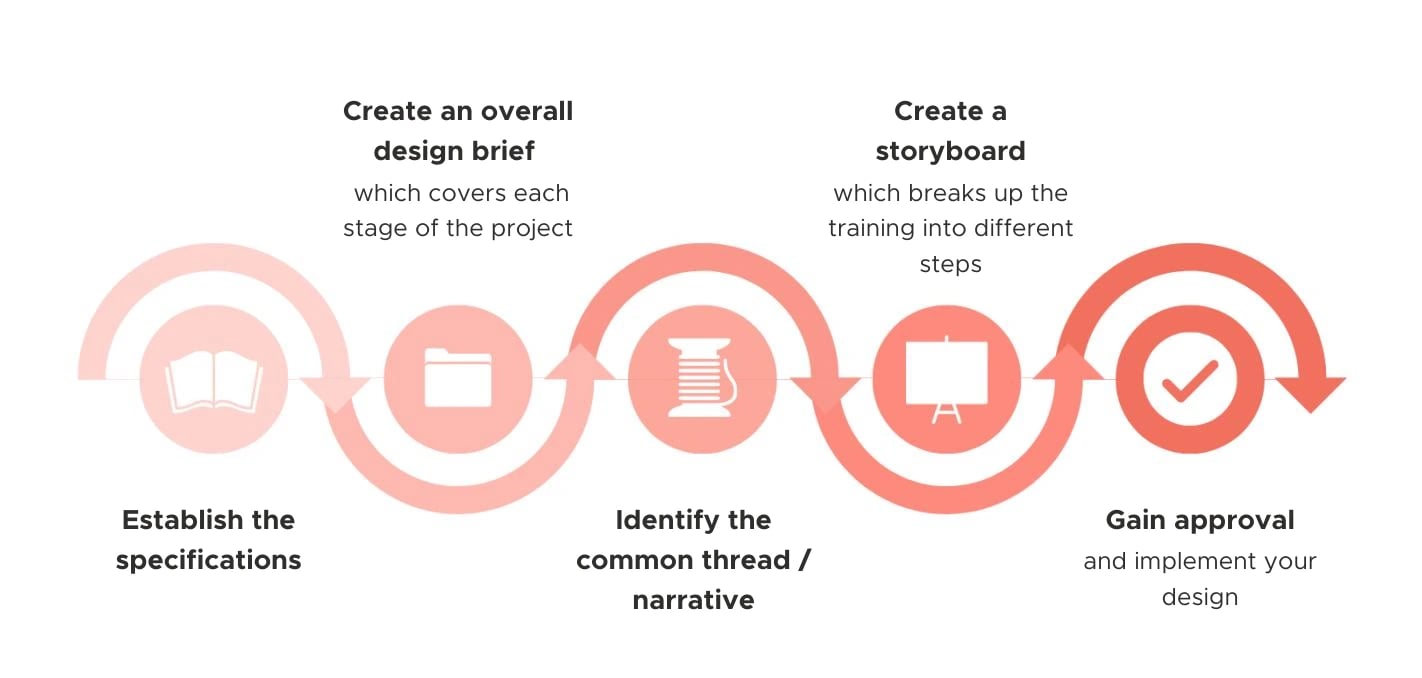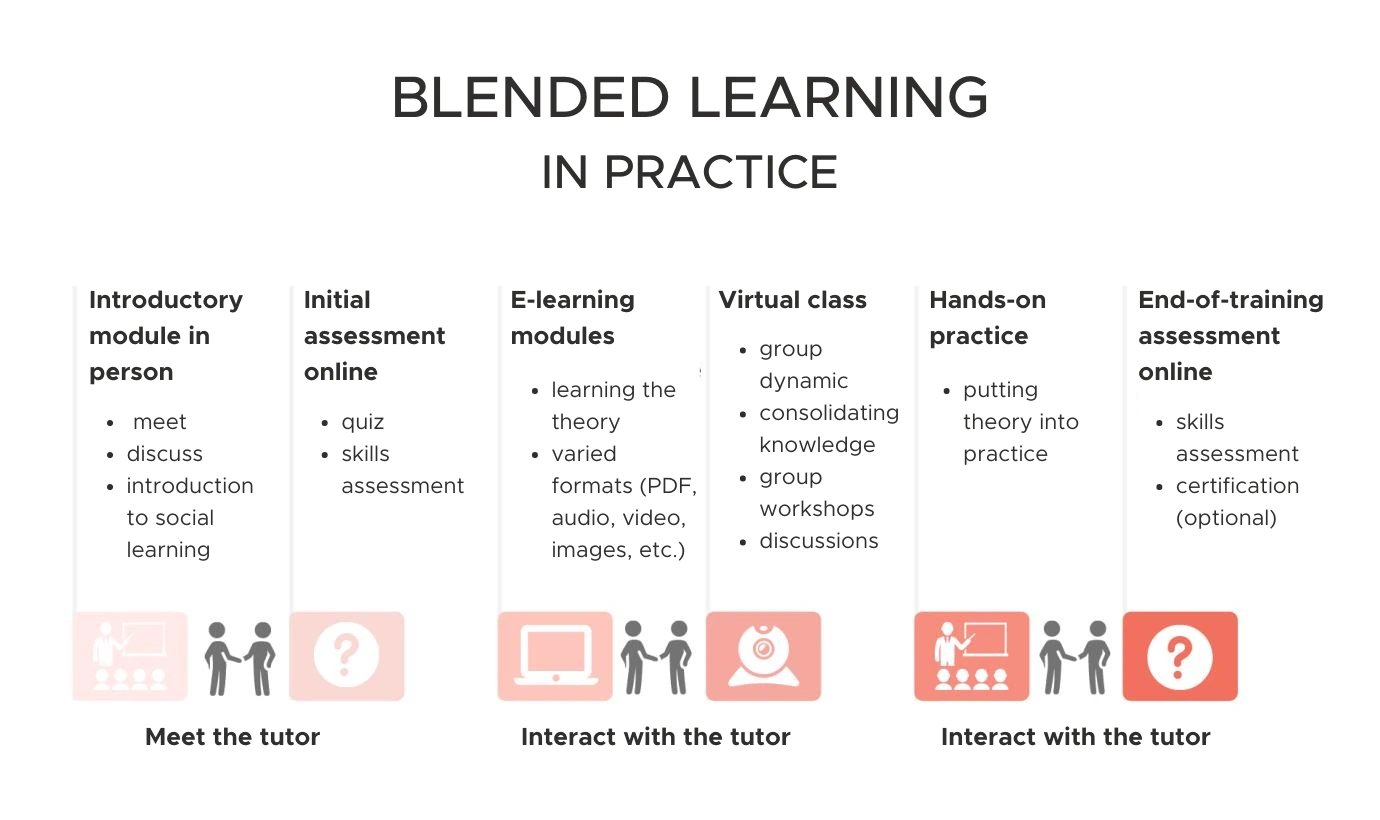7 Minutes of reading
How to design a great blended learning course
When designing a blended learning course, you need to have a solid methodology. And having a methodology implies having several steps that you follow carefully – from determining the scope of the training and having it audited internally and externally to designing, creating, rolling out and assessing the course.
In this article, we’re going to focus on the design phase specifically. Having a good design means taking a step back and analysing your organisation and its needs. Only once you’ve identified your organisation’s needs, aims and objectives can you truly design a decent blended learning course.
Be careful not to confuse the design phase with the subsequent implementation phase. The design phase is really about developing a training strategy. At this stage, rather than creating training modules, it’s more a case of thinking about how you want each module to look and what you want them to cover, in line with the strategy that you established at the outset.
This stage involves defining the training methods, the learning formats and the common or ‘golden’ thread that runs through the training course.
Designing a blended learning course: step by step
Above all, designing an effective and coherent hybrid course means adhering to a series of design steps.

- The specification document contains an inventory of the information gathered over the course of the previous steps. As well as clearly defining the objectives, subject, content and training methods, the specification document allows those involved in creating the course to ensure it is coherent from start to finish.
- The overall design brief brings together all the steps relating to the design of the blended learning training course.
- The common or ‘golden’ thread of the training helps to ensure that the training course is coherent and engaging for learners.
- The storyboard is a reference document for educational and digital designers. Written by the instructional designer for the benefit of training designers, it provides a visualisation of each module, screen by screen, and maps out the training course. It is composed of several boxes which replicate the screen that the learner sees.
- The validation phase concerns everyone involved in creating the training course. Once everyone has given their approval, the designed training course can be advanced to the implementation stage.
6 principles for designing meaningful hybrid modules
1) Use multimedia
A training module which combines text + image or image + sound will have a greater impact on a learner’s brain and memory than just a PDF.
2) Group information together
To ensure that learners make cognitive associations between text and images, avoid displaying information in different places. For instance, if you’re adding an image, place the text equivalent on the same screen.
3) Only include relevant material
Make sure that the training methods are to the point. Remember that you should be able to justify the inclusion of each element and ensure that each one supports the desired training outcomes.
4) Avoid unnecessary repetition
Avoid this at all costs if you don’t want to bore your learners! For instance, if you have some text up on the screen, there’s no point having a voiceover of it as well.
5) Customise the content
The more you personalise how you deliver the training course, the more your learners will feel involved, and even valued. Why not give the course a personal touch here and there to make them feel included?
6) Give learners autonomy
Learners who set their own objectives and targets obtain better results, as this enables them to tap into their motivation.
Designing a blended learning course
During the design stage, the instructional designer or whoever is responsible for designing the training must ensure that they include a variety of training methods throughout the course. If the training course is largely made up of e-learning modules, it’s also important to vary the formats to maintain learner engagement.

Learning formats
- Text: Generally appears on factsheets to summarise the ideas presented during the previous training stages.
- Video: Popular among learners, this format combines visual and audio. Videos can be used to introduce the trainer or create a screen recording to show learners how to do something practical. ****
- Images: Often used to share infographics, key figures or diagrams.
- Quizzes: Generally appear at the end of a module to allow learners to recap on the knowledge they’ve acquired but can also be used as preliminary and final assessments at the beginning and end of a course.
Training methods
- e-learning: 100% online learning via e-learning modules.
- in-person: learners are taught in groups by a trainer in a room.
- virtual classes: similar to face-to-face training, learners are split into groups, assigned a trainer and attend classes at a scheduled time, albeit virtually.
- mobile learning: involves completing fairly short microlearning modules on a smartphone or tablet.
- social learning: learners learn from another by interacting or sharing knowledge via collaborative tools, such as online chats, forums and communities.
- fast learning: involves dividing up training into several small modules which are quick to complete (under three minutes), are to the point, and are based around a specific idea or objective.
- gamification: injects fun into the training experience to maximise learner engagement. More often than not, it tends to involve learners acquiring a series of badges or rewards at the end of a course.
Continue your learning by downloading our expert guide: 'learning in the flow of work' and discover how your learners can access learning as they work without disruption to improve employee performance.


